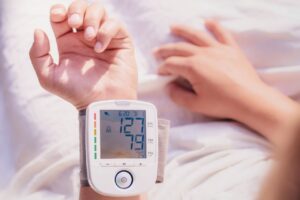How should I monitor my bloodpressure at home? |

On a recent visit to see my mother, I watched her check her blood pressure with her home machine. I was surprised to find out that she wasn’t really following the best procedures for getting an accurate blood pressure reading. I thought a discussion of home blood pressure monitoring would make a good subject for our Health Tip today.
The latest guidelines for the treatment of high blood pressure put more emphasis than ever before on home blood pressure monitoring. There are different options for checking blood pressure at home. First I’ll talk about the different options, then how to make sure you get accurate readings.
There is a device, called an ambulatory blood pressure monitor. This device is about the size of a portable radio with an attached belt or strap that is worn on the body. This is something that your doctor may ask you to use to get a better picture of what your blood pressure is doing throughout the day. You would get it from your doctor’s office. Throughout the day, the machine will automatically check your blood pressure about every 30 minutes, and usually every hour overnight. When you are using this machine, you are also given a diary to write down your activities. When the 24 hours are over you take the machine back to your doctor’s office along with the diary. Your doctor will then review the blood pressure readings in the context of your activities.
In many cases, rather than using an ambulatory blood pressure monitor, we simply recommend that you take your blood pressure at home, or have it checked at your local pharmacy, intermittently at different times of the day. If you are taking your blood pressure in this way, there are a few things that you should do in order to get an accurate reading.
- Choose a good quality cuff that fits your upper arm well. Your pharmacist can help you find the right machine for you. Do not use a cuff that measures anywhere besides your upper arm.
- Occasionally take your machine with you when you see your doctor, so that the doctor or nurse can check how accurately it is measuring.
- Avoid caffeine, exercise, and smoking for at least 30 minutes prior to taking your blood pressure.
- Always sit in a chair that supports your back and allows your feet to be flat on the floor. Sit in this way for at least 5 minutes before you start your machine. (If you sometimes take your blood pressure while leaning back in your recliner, that’s ok, but you have to indicate this when you write that reading down, because it should be interpreted differently by your doctor.)
- Make sure that your arm that is being used for the blood pressure reading is well supported (resting on a table for instance) and relaxed at the level of your heart.
- Make sure that the blood pressure cuff is high enough on your arm. The middle of the cuff should be at about the same level as the middle of your breast bone.
- Keep a good record of your readings, including the date and time of day. If you did anything out of the ordinary, for instance if you had just stopped exercising, always write that down along with your reading so that your doctor will know how to interpret that particular reading. Be sure to take these readings in when you see your doctor.
If you have any more questions just Ask Hanna, our health advisors are here to help.
Image: ©Shutterstock / Albert Rimsky








